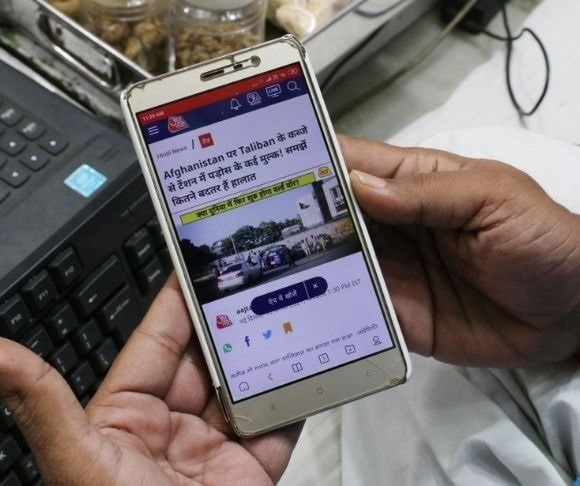The Taliban has regained control of Afghanistan and this time around it’s using social media to gain legitimacy. It’s been 20 years since the organization was in power and much has changed technologically, including social media platforms influencing global politics. Facebook, Twitter, YouTube, Instagram, and other media companies are faced with a few questions with radical repercussions: Is the Taliban violating their posting and sharing rules? Should it be permitted on these platforms at all, even if it is not necessarily breaking any rules, but still using them to control the narrative? Should the people who took Afghanistan by force inherit official government media accounts? How these companies respond to such questions will be pivotal in this digital age, especially in the wider scope of whether they, the online platforms, should treat the Taliban as a legitimate government.
Taliban’s Activity

Kabul airport (Photo by Haroon Sabawoon/Anadolu Agency via Getty Images)
As Liberty Nation has reported, the Taliban seized the capital of Afghanistan, Kabul, as the sitting president and government fled. Back when the Taliban was in power in 2001, the internet was used by only 0.01% of the population in Afghanistan. Now, with multiple officials on social media, specifically Twitter, the Taliban produces videos and is active daily.
Well-known Taliban spokesman Zabiullah Mujahid has been posting regularly over the last few weeks to his 300,000 followers on Twitter. Facebook and YouTube consider the Taliban a terrorist organization and do not allow it to operate accounts. Twitter has refused to ban the group, but it released a statement last Tuesday reassuring the public it would continue to enforce existing rules.
Most applicable to the Taliban are edicts against glorifying violence, posting spam, or attempting to manipulate the public. Until accounts associated with the historically violent organization break the rules, they may remain active on Twitter. Over the last week, Jack Dorsey and his social media company have received an abundance of heat for continuing to ban former President Donald Trump while Mujahid and his fellow Taliban officials are permitted to post.
Facebook, on the other hand, banned the group for being in breach of its “dangerous organization policies.” The media conglomerate hired native Pashto speakers to monitor and translate posts. On WhatsApp, a messaging app owned by Facebook, the Taliban will be “monitored” and not allowed to spread propaganda or to recruit, according to the company. However, WhatsApp is an encrypted messaging service in which only senders and receivers can read the conversation, complicating the ability to monitor the app.
Recognizing Legitimacy
Both Facebook and Twitter have declined to answer questions regarding whether they would hand over Afghanistan’s official government accounts to the Taliban. YouTube released a blanket statement stating it obeys “all applicable sanctions and trade compliance laws” – and the United States has placed sanctions on the Taliban. Facebook has paid a hefty price for how it influenced genocidal behavior and politics in Myanmar. Its history may dissuade the social media giant from getting too involved this time around.
Conflicting updates
Photos and videos have emerged from Kabul depicting chaos and Afghans desperate to escape. Taliban representatives, on the other hand, have attempted to “reassure” the public that the capital is “completely stable and normal.” The Taliban is known for its past oppressive, abusive, and violent policies, including sharia law. Today, it claims to have changed, vying for legitimacy on the international stage as a reformed organization. In their press conferences and social media posts, officials try to cast themselves as peaceful, more palatable, and nonviolent toward civilians.
Afghan civilians have contradictory accounts of life in their country. Anisa Shaheed, a prominent Afghan journalist, tweeted about her life under the Taliban, “It’s been four days since I lost all motivation to work. Throughout years of working as a journalist, I have never felt so frustrated and useless. I receive calls and messages from people I know, who tell me they have been attacked, beaten up, and dragged out of their houses. What should I do? Where should I publish these [stories]? My hands are tied.”
 Another woman, from Kabul, shared that her hopes for her future are crushed: “After high school graduation, I have been working and saving up to pay for my college tuition fees. I will most likely lose that job since working in a shop is not regarded as appropriate for girls. All my plans are ruined.”
Another woman, from Kabul, shared that her hopes for her future are crushed: “After high school graduation, I have been working and saving up to pay for my college tuition fees. I will most likely lose that job since working in a shop is not regarded as appropriate for girls. All my plans are ruined.”
Another Tweet shared an account of a woman with a tattoo being beaten by the Taliban and accused the violent organization of not changing, just becoming smarter and more manipulative.
Tom Joscelyn, a senior fellow at the Foundation for Defense of Democracies, noted the Taliban is “very attuned to Western ears and know how to play to journalists, know how to say things that sound appealing to Western ears, and that is quite deceptive.” Joscelyn’s statements are supported by the fact that the Taliban’s online messages are published in multiple languages. Also, according to the World Bank, only 11.4% of Afghanistan’s population uses the internet, suggesting the group’s target audience is outside of the nation.
In this digital age, social media companies will influence the Taliban’s reach on a global stage, especially in spreading misinformation. Twitter, Facebook, and YouTube have consistently shut down posts spreading “misinformation” about serious topics such as COVID-19 and the 2020 election. Will they continue to fact-check and monitor posts coming out of Afghanistan?
~
Read more from Keelin Ferris.




